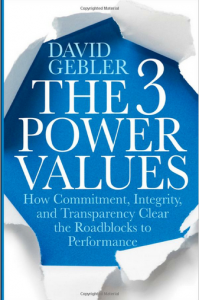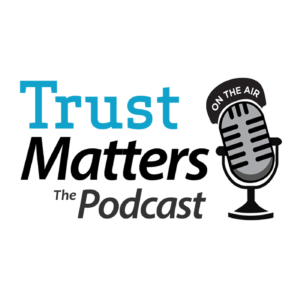 This is the tenth in a series called Books We Trust.
This is the tenth in a series called Books We Trust.
The 3 Power Values is, simply, an excellent book. Author David Gebler’s unique talent is to combine a Big Idea, such as the need to remove roadblocks as the key to performance, with precisely defined linkages between values, culture and behavior. He brings needed commonsense to the often vague, un-actionable, and fog-sculpting enterprise known as organizational effectiveness.
David is a consultant and educator, with 20 years experience helping leaders understand how to use their organization’s culture to improve performance and to stay out of trouble.
The Interview
Charlie Green: David, we spoke a couple of years ago about why companies have so much trouble getting a handle on ethics issues and it seems like things are getting even worse.
David Gebler: I agree. Ethics scandals fill the papers every day. We don’t see change because we’re not dealing with the real issues that lead people to do bad things. We think that regulations will define outer boundaries to actions and that morals will guide us inside those boundaries. And that just isn’t the case.
Charlie: Why not? You would think that following the rules and knowing right from wrong would be enough.
David: What doesn’t get factored in is the environment we work in. Whether we follow the rules, even what we think is proper, is heavily influenced by the culture. Social norms tell us whether it’s OK to flout the rules. The norms also tell us whether to feel entitled or remorseful when we cheat or do something wrong.
Charlie: When is it OK to violate rules?
David: Charlie, even you have driven over the speed limit. But you wouldn’t call it morally reprehensible, I suspect. We have normalized that speeding, up to a certain point, is something we all do. So even if it’s illegal, we don’t see it as a moral issue.
Charlie: Did you say that moral issues are also subjective? What do you say to those who say morals are morals, right is right, and wrong is wrong?
David: The truth is, even our definition of what is right is subjective. Leaders in behavioral economics, such as Dan Ariely, point out that everybody has the propensity to be dishonest, and almost everybody cheats—just by a little. The behavior of almost everyone is driven by two opposing motivations. On the one hand, we want to benefit from cheating and get as much money and glory as possible; on the other hand, we want to view ourselves as honest, honorable people.
What determines whether we feel good about ourselves is the environment we’re in. If we’re in a culture where cheating is frowned upon, people will cheat less, because cheating impacts their sense of self. But if the culture is to take advantage and win at all costs, then cheating and cutting corners becomes just the way we do business.
Charlie: So if the key factor is culture, why do so few leaders tackle this issue head on?
David: Culture is so intangible that leaders hesitate to dive in – not even just to understand it, much less to tweak it. Many leaders haven’t focused on measuring and managing culture, not realizing that they can. Most don’t understand whether their culture hinders or supports performance, much less the implementation of strategies. And finally, many leaders don’t even know whether their culture encourages unethical or illegal conduct.
Charlie: In the book you explain that three “Power Values” are essential to get a handle. What do you mean by that and what are those values?
David: Twenty years of work with companies showed me that three values – integrity, commitment and transparency – stand out in fostering identification and community. I call these the power values because they can influence specific behaviors that in turn positively influence an organization’s culture. The chain is: values > behaviors > culture. It is the behaviors that nudge the organization’s cultural components (goals, principles, and standards) into alignment.
By focusing on the specific behaviors that make up integrity, commitment and transparency, you can transform negative behaviors impeding performance into positive behaviors supporting performance. This is how you measure and manage culture as a way to rev up performance and reduce risk.
Charlie: What if employees in the organization don’t understand these values?
David: Most employees already hold these three power values personally. When the power values are highly visible in an organization, they clarify the organization’s intentions and give employees a unifying sense of purpose and direction.
Employees who share their principles, goals, and outlook – the essence of the power values – can let their guard down a bit. They can trust that they will be understood, that there will be fewer booby traps, and that their leaders and coworkers will generally act in a predictable way, consistent with their shared values.
Charlie: What’s the connection between these power values and the kinds dysfunctional cultures we were just talking about?
David: In a positive corporate culture, employees feel good about themselves and their work (commitment). They raise issues and freely ask questions (transparency). They don’t feel challenged by unfair or inconsistent work processes, because people take personal responsibility for their actions and live up to their commitments (integrity).
When the elements of culture are out of alignment, frustrations arise. If principles are unaligned with goals, employees disengage and don’t feel a vested interest in their work (lack of commitment). When goals are out of sync with standards, unfairness arises as managers and employees “do what they have to do” rather than what they have said they would do (lack of integrity). And when standards are aligned with values, employees see that the organization’s actions are inconsistent with its principles, and it becomes hard to ask uncomfortable but important questions and ensure that the truth is heard (lack of transparency).
Charlie: How can you foster a positive corporate culture right from the start?
David: Organizational culture isn’t something that can be faked – or “implemented” – by leadership. The culture is simply the way the organization and its people conduct themselves. Organizations have cultures from their outset, though few start-ups spend time defining their culture when they’re small and everyone knows everyone.
When a culture goes bad, it’s not a sudden event; it’s a case of of slow erosion over time. Things begin to change. At the beginning it’s little things, e.g. a business decision made in the heat of the moment when the decision-maker didn’t feel the urgency to deal with the long-term impact at the time of the decision.
Leaders who understand the role organizational culture has in shaping behavior and performance, however, will be mindful of the early warning signs of trouble. Successful culture management means that leaders recognize the first steps down the proverbial slippery slope, and take actions to address them when they’re still small.
To do that, leadership must have a clear sense of a) what kind of culture is needed to achieve the organization’s goals, and b) what behaviors are needed to ensure that the desired culture is sustained. Successful leaders know that the small things matter greatly, and that veering off course is not to be done lightly or without serious plans to right the ship.
Charlie: Thanks, David, for sharing your insights. Until reading this, I also didn’t have a good idea of how one could actually manage culture. You have managed to educate me greatly!
David: A pleasure, Charlie .


 My last three posts –
My last three posts –  Yesterday I wrote about
Yesterday I wrote about The term “financial advisor” covers a wide range of activity, from insurance sales to asset manager to broker to financial planner, and many more. Both providers and consumers of financial advisory services are well advised to get some perspective about this business.
The term “financial advisor” covers a wide range of activity, from insurance sales to asset manager to broker to financial planner, and many more. Both providers and consumers of financial advisory services are well advised to get some perspective about this business. Charlie: What’s driving this move? What’s been the customer experience of the financial advisory business over the past 30 years? The past 10?
Charlie: What’s driving this move? What’s been the customer experience of the financial advisory business over the past 30 years? The past 10? This is the tenth in a series called
This is the tenth in a series called